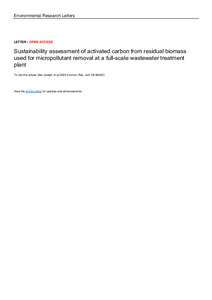| dc.date.accessioned | 2020-06-29T15:13:45Z | |
| dc.date.available | 2020-06-29T15:13:45Z | |
| dc.date.issued | 2020-05-29 | |
| dc.identifier | doi:10.17170/kobra-202006291373 | |
| dc.identifier.uri | http://hdl.handle.net/123456789/11610 | |
| dc.description.sponsorship | Gefördert durch den Publikationsfonds der Universität Kassel | ger |
| dc.language.iso | eng | eng |
| dc.rights | Namensnennung 4.0 International | * |
| dc.rights.uri | http://creativecommons.org/licenses/by/4.0/ | * |
| dc.subject | life cycle assessment (LCA) | eng |
| dc.subject | biochar | eng |
| dc.subject | social risk assessment | eng |
| dc.subject | global warming potential | eng |
| dc.subject | sustainable resource management | eng |
| dc.subject.ddc | 630 | |
| dc.title | Sustainability assessment of activated carbon from residual biomass used for micropollutant removal at a full-scale wastewater treatment plant | eng |
| dc.type | Aufsatz | |
| dcterms.abstract | Activated carbon (AC), used for removal of organic micropollutants in European wastewater treatment plants (WWTPs), is usually produced from non-renewable resources that need to be transported over long distances. Utilising local residual biomass as a raw material may be advantageous in terms of sustainability. This study investigated the environmental and energy balances of using biowaste and biomass from landscape management for micropollutant removal at a commercial scale WWTP. Both residual biomasses were processed using the integrated generation of solid fuel and biogas from biomass (IFBB) technique to obtain a press cake that was used as feedstock for AC production. The results showed a lower global warming potential (GWP) and cumulative energy demand in comparison to a fossil-based conventional AC Differences in GWP between residual and fossil ACs were enhanced when the end-of-life incineration step was considered, and residual AC had a lower social risk associated with its production. Energy efficiency of AC production was substantially increased by utilising waste heat generated in the pyrolysis process of biochar production and by using electricity generated in a combined heat and power plant using biogas from the methanation of IFBB press fluids. Converting residual biomass into activated carbon using IFBB and a state-of-the-art pyrolysis and activation unit along with energy recovery would improve WWTP sustainability and self-sufficiency in terms of the raw materials required. | eng |
| dcterms.accessRights | open access | |
| dcterms.creator | Joseph, Ben | |
| dcterms.creator | Kätzl, Korbinian | |
| dcterms.creator | Hensgen, Frank | |
| dcterms.creator | Schäfer, Bernhard | |
| dcterms.creator | Wachendorf, Michael | |
| dc.relation.doi | doi:10.1088/1748-9326/ab8330 | |
| dc.subject.swd | Aktivkohle | ger |
| dc.subject.swd | Kläranlage | ger |
| dc.subject.swd | Biomasse | ger |
| dc.subject.swd | Umweltbilanz | ger |
| dc.subject.swd | Pflanzenkohle | ger |
| dc.subject.swd | Ressourcenmanagement | ger |
| dc.subject.swd | Nachhaltigkeit | ger |
| dc.type.version | publishedVersion | |
| dcterms.source.identifier | eissn:1748-9326 | |
| dcterms.source.issue | Number 6 | |
| dcterms.source.journal | Environmental Research Letters | eng |
| dcterms.source.volume | Volume 15 | |
| kup.iskup | false | |


